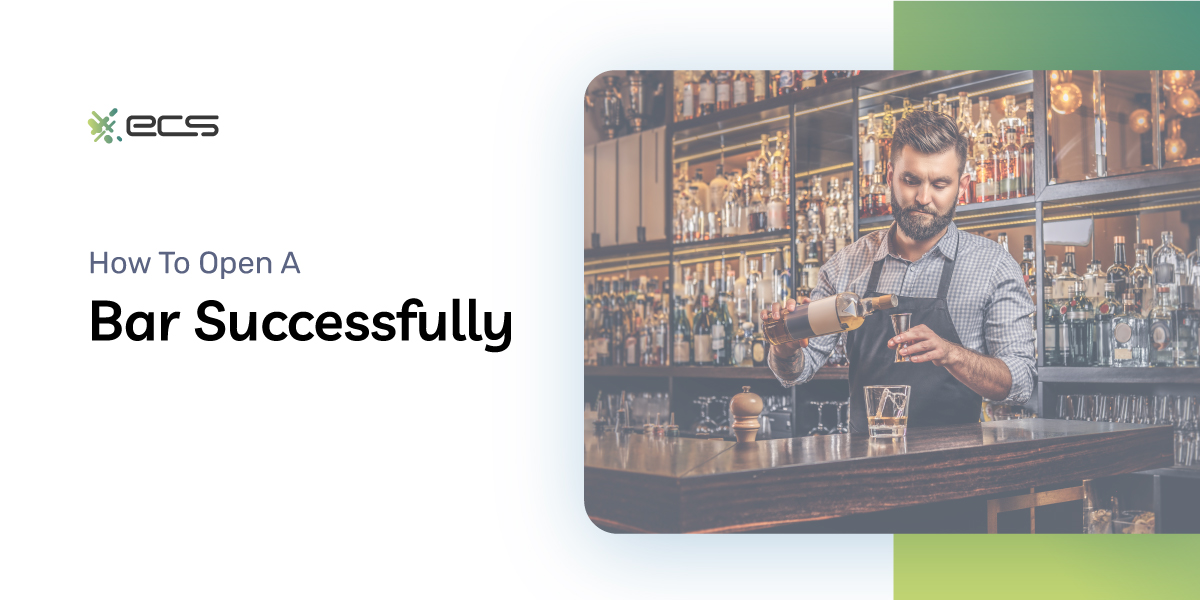Opening a successful bar is the dream of many aspiring entrepreneurs. Whether you already have experience in the bar and restaurant industry or whether you’re just getting started, the process of how to open a bar can seem daunting.
But don’t be discouraged. Plenty of people have opened successful bars, and there is a set of best practices that you can use as a blueprint along the way.
Using these best practices and carefully outlining your plan and goals will drastically improve your chances of success. Not only that, but you’ll also avoid many of the pitfalls that newer bar owners succumb to.
To help you along the way, we’ve compiled a complete plan to take you from an original idea to your grand opening. If you carefully follow these steps and put in the effort required to plan accordingly, you’ll be well on your way toward being a successful bar owner.
In this article, we’ll cover the following steps to use as an opening a-bar checklist.
- Developing a bar concept
- Market research and planning
- Cost projections and financing
- Assembling your staff and team members
- Choosing the right technology and payment processing
- Preparing for the opening
Developing A Concept
Your concept choice in the restaurant and bar industry is critical to starting a successful bar from scratch. Beginning with a solid concept tailored to your local market is one of the best tips for opening a bar successfully.
Your concept describes what the bar is about. The concept is based on your bar’s design, the drinks, your staff, and the customers you attract. Without a concept, a “bar” is just a building that serves drinks. It has no differentiating characteristics that make it stand apart from every other bar in the neighborhood.
Careful research and planning form the foundation of a strong bar concept. This gives you a leg up on the competition. It also makes it easier for you to target customers who will be most receptive to your overall vision and marketing messages.
Without a well-defined concept, you’ll have to market to a more general audience, which is often more difficult and offers lower returns. Effective targeting of your core customer is everything when it comes to marketing.
A strong and well-defined concept allows you to do just that. Bar industry trends can change and bring new concepts, but the tried and true concepts can still work when executed correctly.
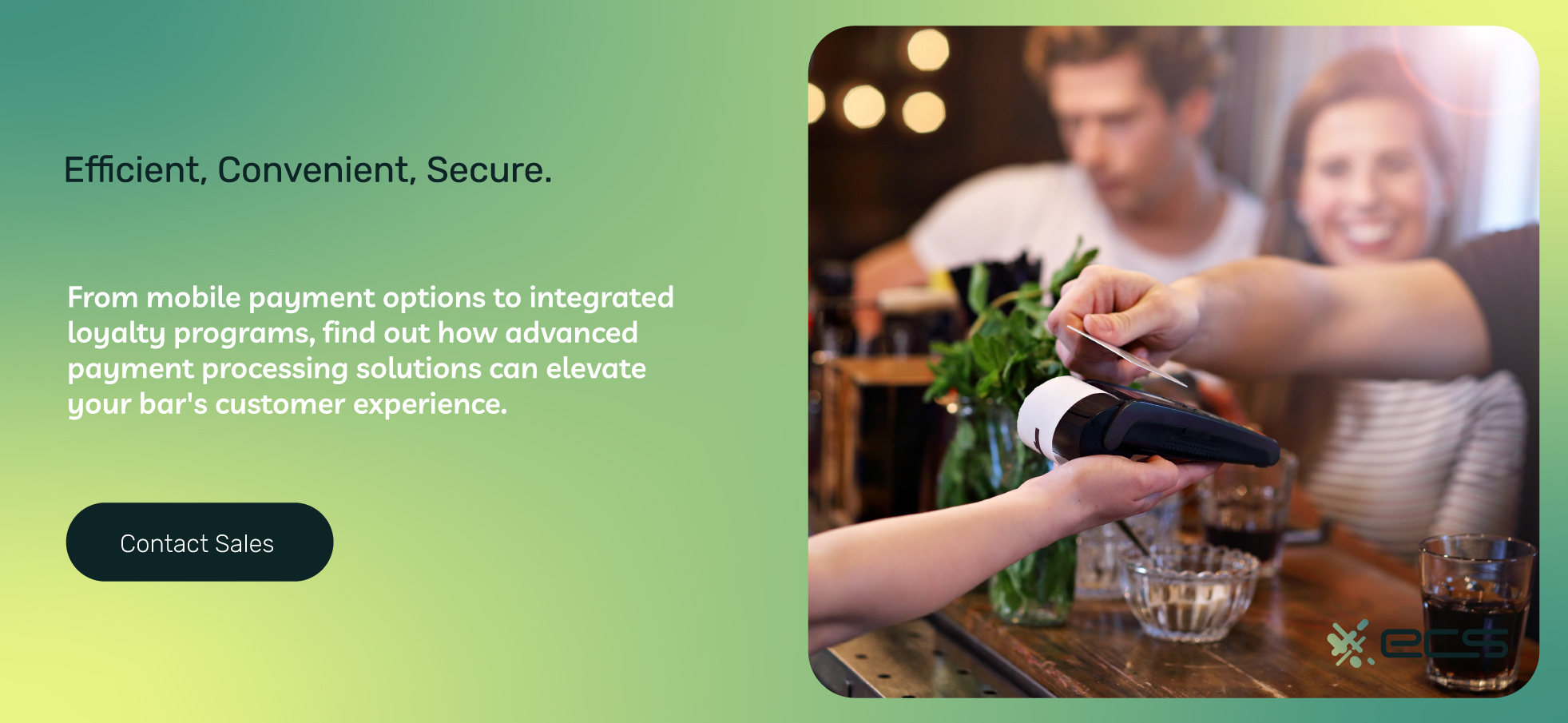
Bar Concept Examples
As a bar owner, this is the part of the planning where you get to be most creative. Your concept can be just about anything you want it to be. Just remember to base it on the realities of business and your local market.
Tailoring your concept to your local market is essential, as a great idea that suits one city may not necessarily translate well to a different city.
Below are the most common bar concepts. Each can have a near-limitless number of options for making the concept your own and tailoring it for your market.
Sports Bar Concept
A sports bar concept builds upon the neighborhood bar theme but with additional seating and food options. There is also a focus on TVs that are viewable from anywhere within the bar.
Sports Bars can still be a popular concept depending on your local market. However, there is generally competition that already exists, so you’ll need to offer customers something they can’t find in other similar concepts.
Sports bar concepts can have higher startup costs due to the need to buy food preparation hardware, extensive remodeling, and an audio/visual system.
When opening a sports bar, you’ll want to focus mainly on differentiating your bar from other competing sports bars.
Specialty/Upscale Bar Concept
A specialty or upscale bar concept focuses on a unique aspect of drinking. A wine bar is an example of a specialty bar concept. Other specialty concepts include an upscale interior with a designated dress code for all patrons.
There are many options here, and you can focus on specific drinks or specific interior design choices. Whatever your choice is, your concept must be immediately recognizable when someone walks in.
Startup costs can be lower for a specialty bar since you’re often just focusing on one type of drink or a category of drinks. You can also open a specialty bar without food options. Other concepts like sports bars generally require food options to be successful.
Neighborhood Bar
This is your typical bar. It’s a simple concept, and it’s difficult to launch in an established market. Most neighborhood bars have been in business for years, even generations. They become a mainstay in the community.
Neighborhood bar concepts can be attractive since they often have lower startup costs than others. Neighborhood bars generally have understated furnishings. They serve typical, low to mid-priced drinks that appeal to the local market.
The downside is that a bar like this is often the hardest to market. Without a unique trait, it’s hard to target your preferred customers in a way that entices them to switch to your location.
Market Research For Bars
Before committing to your concept, you must conduct marketing and location research to ensure it’s viable. During your research, you may decide to tweak your concept or abandon it altogether and find a new one.
If your market won’t support your concept, it doesn’t matter how good the idea is. It simply won’t work if the market isn’t there.
Study The Competition
You’ll begin your research by carefully analyzing the competition. Your competition will be every bar in the area, especially those with the same characteristics as your concept.
Look for established bars and learn what they offer to their customers. Examine their social media and advertising to see what they’re doing right and where you can find an opportunity they may be missing.
Ideally, your concept should fill a need that is either totally unserved or underserved within your local market.
Location Selection For Bars
At this stage, you’ll want to consider a few possible locations for your bar. You won’t make a final choice until your budgeting and financial projections, which we’ll cover later.
For now, you want to familiarize yourself with zoning laws and the properties that will allow your concept.
Different counties and municipalities have different regulations regarding bars and serving alcohol at a business. You’ll likely want to use a local commercial real estate agent.
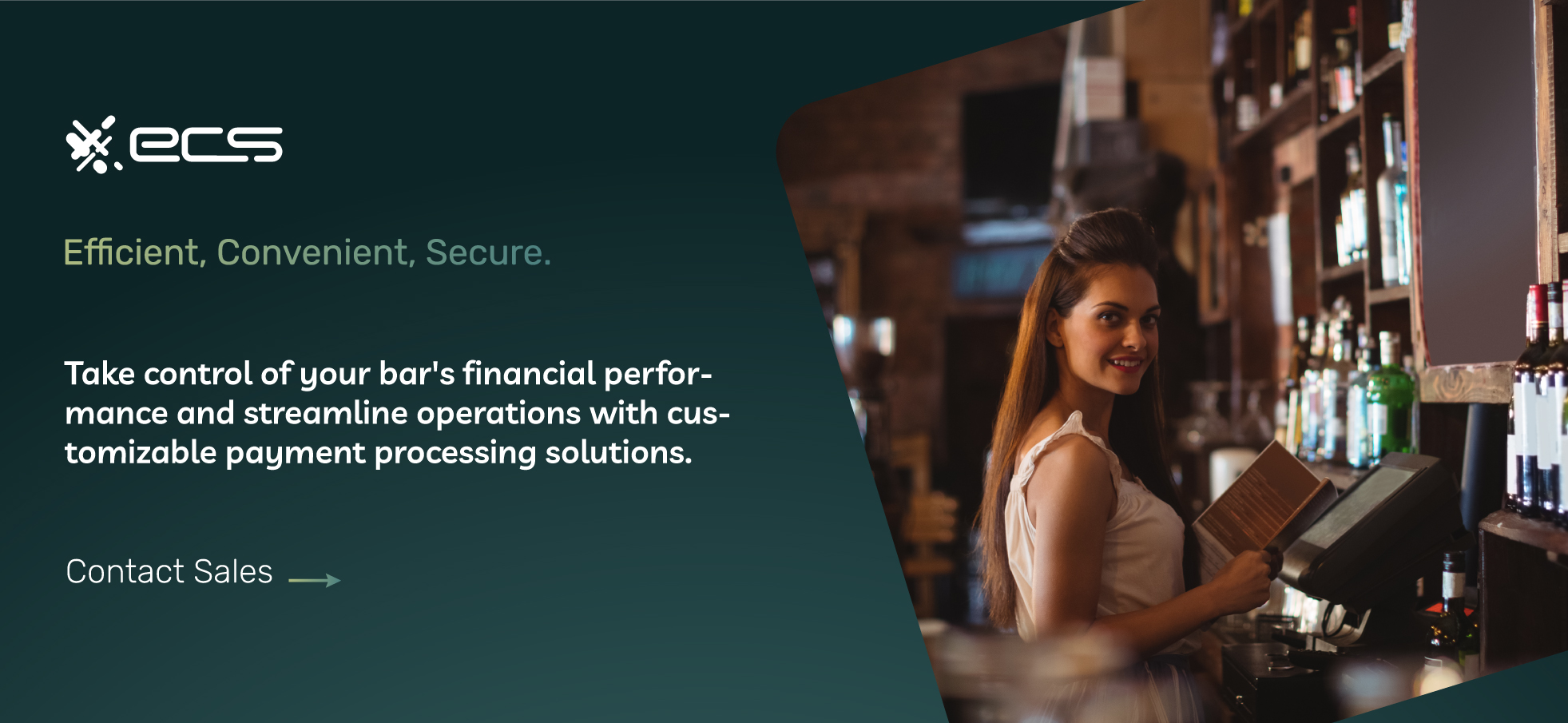

Determine Your Target Audience
The next step in market research will be identifying your target market. Your concept will determine the target market. Things like your interior, food options, and price points will all go into determining your target audience.
Next, you’ll want to determine if your target audience exists in the area you want to open your bar.
To do this, you’ll need demographic information regarding the neighborhood and surrounding area.
You could do this yourself, but you’ll likely want to hire a professional to conduct this research. They will have access to the latest demographic data on your area.
This type of research will cost between $2,000 and $5,000, depending on the level of detail you require.
You can also choose to have a local customer focus group conducted. Market research firms administer these focus groups. The cost can range between $5K and $10K for a smaller business like a bar.
The market research firm will conduct focus groups with locals to determine how receptive they are to your concept. They’ll also determine their spending habits and other preferences related to bars and entertainment.
Focus groups like this can help you determine your price points and other options and are often well worth the cost.
For example, you’ve likely noticed that large franchise businesses rarely fail when they open a new franchise location. Part of the reason is that the franchisor conducts careful market research and focus groups to determine the suitability of each new location.
The reason is because the franchisor already knows they have a successful concept.
You want to mimic this blueprint as much as possible for your bar through market and location research.
Startup Costs & Financial Projections
Focusing on your funding and financial projections are your next steps moving forward. You’ll want to include your financial projections regarding your startup costs and forecasts once you open.
This can help you determine your cash flow to better regulate how much debt you should take on to get the bar underway.
For example, the typical bar has the following breakdowns regarding cash flow and where it needs to be spent.
75%: This is the sales allocated to your major expenses. This includes your overhead costs, such as your lease and utilities, inventory costs, like food and beverages, and labor costs.
15%: This is the cash to pay for minor expenses. These include your payments to any consultants or experts, such as accountants. It includes your technology expenses, small furniture like tables and chairs, and insurance or regulatory filings.
10%: This is your profit margin. The range for a typical bar is between 4% and 10% of sales becoming profit.
If you use these numbers as a baseline, you can see why accurate forecasting is so important. There isn’t much room for error, and you can quickly get into a negative cash flow situation, especially early on.
Another important aspect of forecasting is if you’re trying to secure financing. Your lender will require highly detailed reports on your projections.
If you are looking into more merchant financing options, contact ECS Payments.
Forecasting Sales
Financial planning for bars is complex, especially if you have no experience in this area of business. If you’re trying to secure outside funding, it may be necessary to consult an expert.
You have a few choices in this regard, and the two most popular are:
Bar industry Consultant
Some consultants specialize in the bar industry. These experts can be beneficial when organizing your startup costs and creating the forecasts necessary to secure outside funding.
They add to your startup costs, but their expertise and experience can be well worth it.
Accountant
A competent accountant may not have specific bar expertise, but they can help you generate forecasts based on actual numbers and operating costs.
An accountant will help you accurately determine your actual expenses. The accountant can then create several projections and targets that you’ll need to hit to turn a profit.
Whether you choose an accountant or a specialized industry consultant, make sure to include these costs when budgeting for a bar opening.
Bar Licensing Requirements
Bars have to deal with more regulations and licensing issues than almost any other type of retail business. Your overall startup strategy should allow enough time and budget to work through the process.
Liquor License
Obtaining your liquor license will likely be the most time-consuming task to fulfill all your legal obligations before opening.
It’s highly recommended that you consult a liquor license lawyer specializing in your area. This portion of your startup strategy will also take longer than you likely anticipate, so start the process as early as possible.
Beer or Hard Liquor
In many locations, obtaining a liquor license for wine and beer takes less time than one for complex liquor sales. This can vary, but your chosen bar concept will influence the liquor license process.
Bar Lease
You will need a lease before you get your liquor license. The property, not the bar owner, typically receives the liquor license in most areas. You’ll require a signed lease before you can get a liquor license.
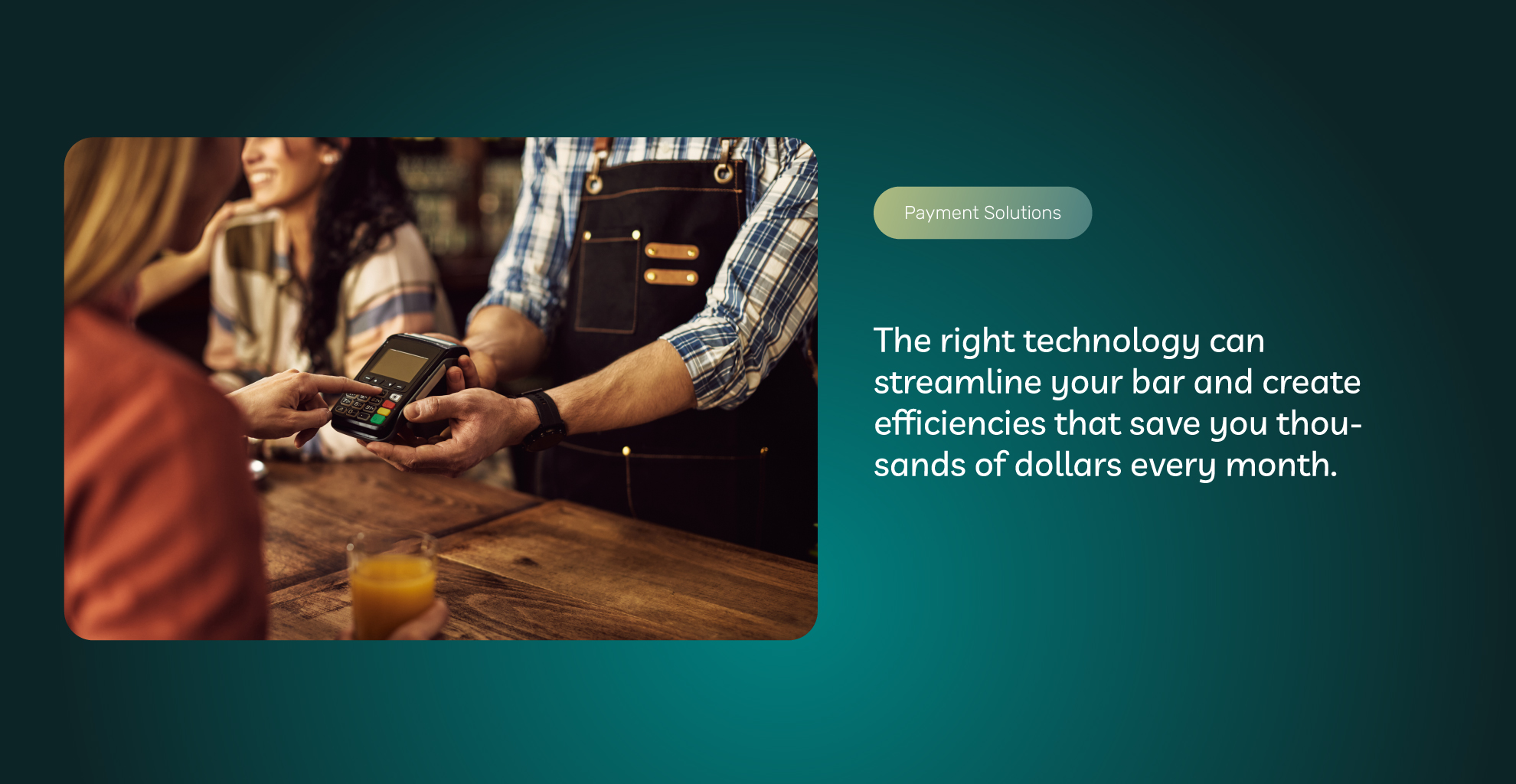
Insurance Requirements For A Bar
As with most aspects of opening a bar, you’ll need to deal with specific requirements when it comes to insurance.
Since you’ll be serving alcohol, you will need liquor liability insurance on top of your general liability insurance. You must obtain and maintain this insurance to meet the liquor license requirements in most locations.
General liability insurance will not cover issues related to alcohol sales and consumption.
Factors That Can Influence Bar Insurance Premiums:
- Bar size
- Activities inside the bar (i.e., dancing, live music)
- Type of alcohol served
- Total alcohol sales
- Location
- Additional coverage you may want, such as insurance to cover bar fights or crimes committed by intoxicated customers
Bar industry statistics show you can expect to pay between $3,000 and $5,000 annually for comprehensive bar insurance.
Designing and Building A Bar
One of the more exciting parts of opening a bar is conceptualizing the design of the bar. This is where your creativity and brand personality can really shine through.
Bar Design
Your original concept will influence your bar design the most. The design of your bar needs to follow a cohesive theme that immediately communicates to customers what they can expect when they walk through the door.
Your design and atmosphere should draw people in, set you apart, and hopefully offer an enticing display for free social media marketing within personalized stories, tags, and reels. You know, if you’re into free advertising through the ever-so-popular socials.
Design can be a powerful tool to draw people in and also persuade them to stay. Of course, the longer consumers stay, the more revenue you are likely to incur.
Bar Layout Efficiency & Atmosphere
Your bar layout is essential to ensure your bar is both efficient and has the right atmosphere. You’ll need to balance these two forces to create the perfect layout.
For example, a bar with an inefficient layout will lead to drink delays and difficulty when customers order drinks. But a bar built for maximum efficiency likely will have a poor atmosphere that feels more like a fast food restaurant.
The goal is to find the perfect balance for your concept.
Things To Consider For Your Bar Layout:
- Bar shape (oval, round, straight, two-story)
- How many bartenders your bar can fit
- Bar material (wood, marble, granite, brick, metal)
- Stations needed at the bar (blenders, taps, shelves, glasses, garnishes)
Bar Furniture
Your choice of bar furniture needs to fit your concept perfectly. So, this is one area where you want to reserve a portion of your budget to ensure you can secure the type of furniture you need, depending on your bar decor ideas.
Depending on your concept and the size of your bar, the prices can vary greatly. Overall, expect to budget between $5,000 and $50,000 for your bar furniture.
Bar Equipment Costs
Besides your furniture, you’ll need to buy the essential equipment to run your bar. This includes tap lines, sinks, dishwashers, and other items.
The costs for these items are easier to budget for since most bars of the same type all use the same essential equipment.
Typical bar equipment includes:
- Tap lines: $1,000 each
- Sinks: $1200
- Glasswasher: $3000
- Coolers: $2,000 – $5000
- Ice machine: $2500
- Soda guns: $300-$500
- Drainboards: $500
Overall, you should expect to budget around $20,000 for your essential bar equipment. Remember that your concept and bar size can cause this figure to vary quite a bit.
You can also consider bar equipment maintenance costs, but those generally won’t start to accrue until several months after opening.
Marketing And Branding
Marketing and branding can be difficult for a new bar owner. But by following some simple steps, you can make sure you stay on the right track and avoid muddying your brand or wasting money on ineffective promotions.
Branding
Your branding should always return to the initial concept and your original business plan mission statement. When it comes to your brand, let those two things inspire everything you do.
The more cohesive and comprehensive your brand image is, the easier it is to market your bar. When your brand does all the talking for you, there is less need to “sell” the idea of your bar to potential customers.
Different types of bars will require different branding strategies.
To develop your brand, you’ll want to consider the following:
A clear mission statement: A clear mission statement should describe why you created your bar, what it offers customers, and what sets it apart from other experiences in town. The mission statement will influence everything from your drink menu development to your bar layout.
Visual Identity: A brand is more than words you communicate to customers. Often, your brand is more about visual identity. What do your furniture and logo say about your brand? Is it all cohesive?
Your bar’s visual identity and branding should allow customers to walk in and instantly recognize the experience they will have.
Stay on brand across all channels: People often forget the importance of this aspect as a bar progresses beyond its opening. Your social media, advertising, and all channels must share the same brand messaging.
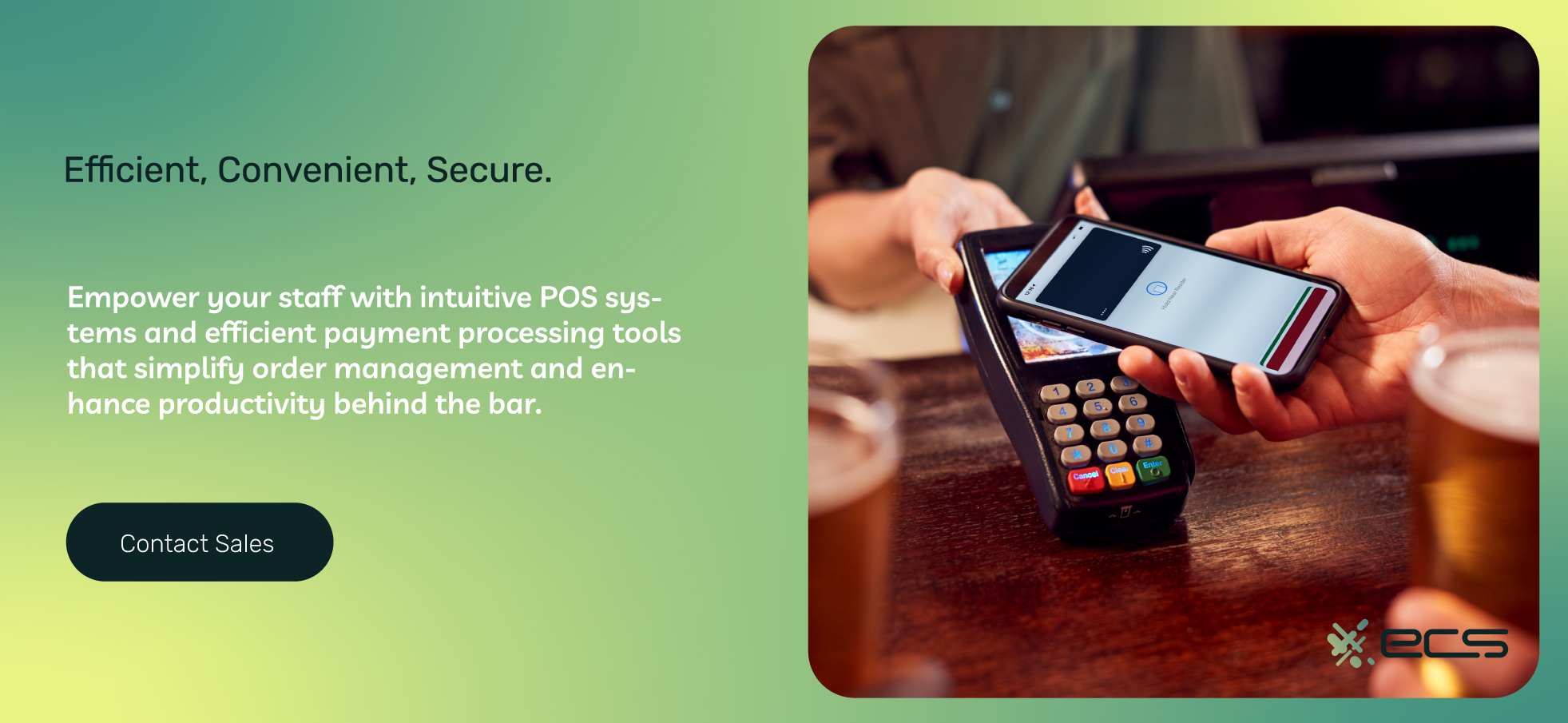
Social Media For Bars
If your bar focuses on classic cocktails and upscale classic furniture, you don’t want to embrace the latest internet trends with your social media presence. You want to maintain that classic atmosphere across your social media and all channels.
Social Media is a powerful way to promote your bar locally, but you want to ensure it follows your branding and messaging.
Bar Marketing Strategies
Marketing for a bar will depend on your budget. You also may want to hire a consultant or agency to help you with this part of your business. However, hiring an agency can have high costs. There is also no assurance of guaranteed results like with other professional services. So you have to consider this carefully.
Marketing generally falls under two main categories when opening or managing a bar.
Outbound Marketing
Outbound marketing for a bar or small business is any type of outreach that you pay for. For example, paying to appear in Google search results would be a form of outbound marketing.
Other outbound marketing includes radio ads, TV ads, or flyers delivered to local residents.
Bar Events And Promotions
The other primary type of marketing bars will be in the form of promotions. Promotion can be anything from a happy hour event to local business collaborations.
Inbound marketing is when you actively attract customers through your own efforts rather than relying on an outside entity, such as hosting promotions.
Hosting promotions or activities at your bar can be a low-cost way of increasing awareness for your bar and building your customer base.
Try to host events when appropriate, as they contribute significantly to making your bar an integral part of the local community. Don’t underestimate their power.
Inventory Management
Inventory management is critical for a bar to maintain its profit margins. This is especially true for poured drinks such as hard liquor. Over-pouring can happen due to poor training or simply oversight by bartenders and staff.
However, if left unchecked, that little extra with each drink quickly adds up over the month, especially with a large bar.
Inventory Formula
A simple formula to start with will use your existing inventory plus any received inventory within a given period. You will then subtract the ending inventory after a specific period, for example, after a weekend.
[Starting Inventory] + [Received Inventory] – [Ending Inventory] = Total Inventory Sold
You will then reconcile this with your sales receipts to ensure everything is accounted for.
Minor discrepancies are expected due to spills and human error. But if you’re noticing consistent or growing discrepancies, something is likely wrong, resulting in unnecessary revenue loss.
Open Bottle Inventory
Some bars weigh open bottles to keep more accurate tabs on inventory. Some bars choose to do “weightless” inventory checks of open bottles. Weightless measuring involves simply eying the bottle and recording how much is left.
Smaller bars often leave a liquor bottle on the shelf for days or longer. It’s usually not worth it for high-volume bars to do this type of open-bottle inventory.
Payment Processing For Bars
When opening a modern bar, your choice in payment processing is one of your most important decisions. Today, payment processing isn’t just swiping cards. Instead, it’s part of your entire business operation.
When choosing payment processing, you’ll want a payment processor with experience in the bar industry and an understanding of liquor sales. Both of these things require specialized processing, and if you choose the wrong processor, you could pay more in fees with every transaction.
What To Look For In A Bar Payment Process
Experience
Focus on a payment processor’s experience and whether they have experience processing payments for liquor sales. For example, ECS Payments holds a reputation as a leader in liquor payment processing within the restaurant and bar industry.
Using an industry leader like this ensures you get the lowest rates for your liquor payment processing.
Latest Payment Technology
Next, ensure your payment processor offers the latest payment options. This includes mobile card readers and the ability to accept digital wallets such as Apple Pay or Android Pay.
Integration With POS Systems
Your payment processor should understand all the popular POS (point of sale) systems that bars use and be able to help you integrate your payment processing with those systems.
Your payment processor can also help you choose the right POS system based on your bar concept, layout, and anticipated sales volume.
Customer Service
Customer service is the most important of all. If anything goes wrong with your payment processing, you need answers fast. Any downtime can mean lost revenue.
Ensure your payment processor offers in-house customer service you can reach when needed.
An online payment processor or a big aggregate payment processor can leave you waiting days for an answer.
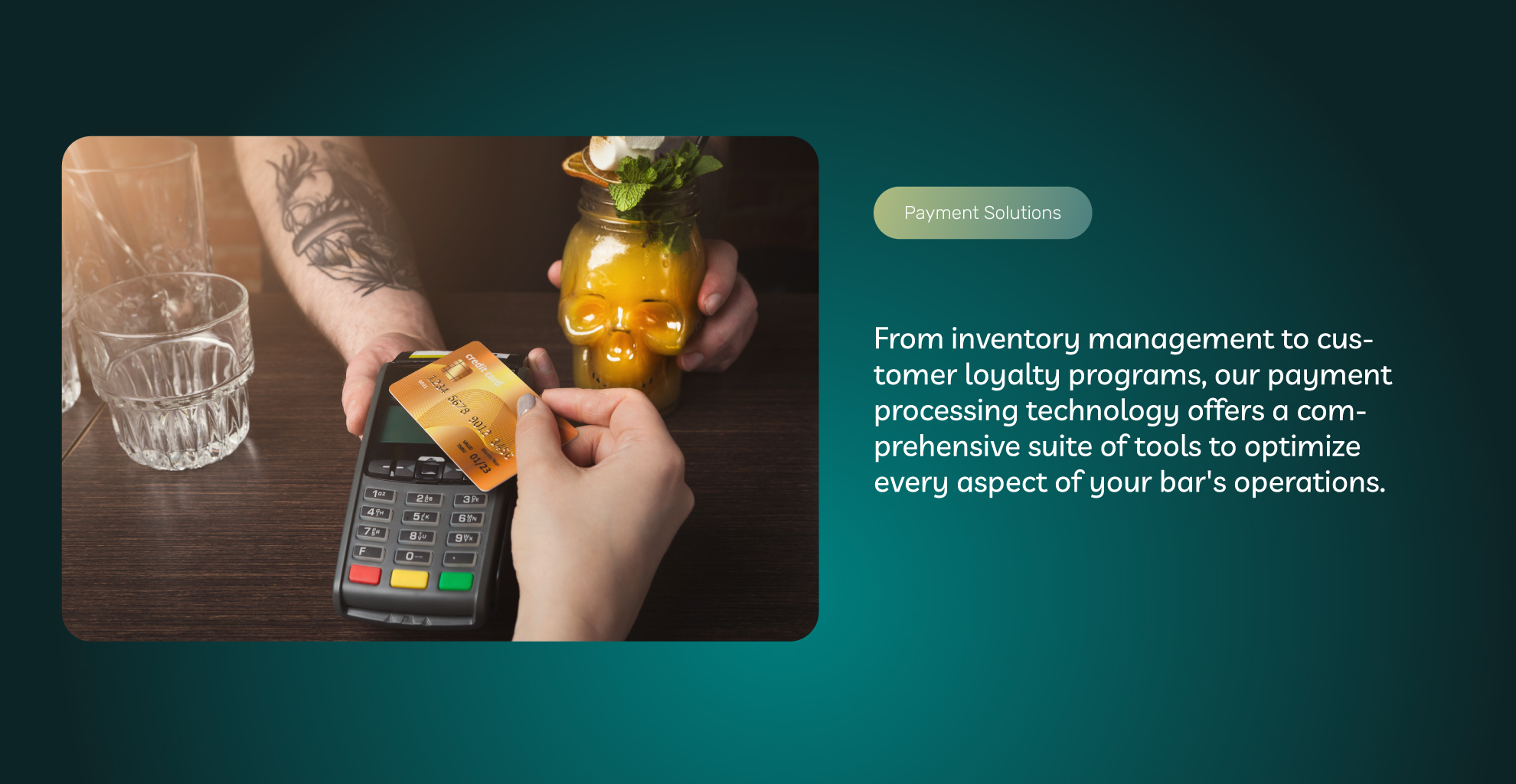
POS (Point of Sale) Systems
Almost every bar today uses a POS system to handle cash and electronic payments. A POS system integrates hardware and software to extend its usefulness beyond accepting payments.
A POS system can help with bar revenue tracking, inventory, employee time tracking, and more. It’s a critical piece of technology and has become central to most modern bars.
There are several options to consider when choosing POS systems for bars that you will want to consider before making your final decision.
Drink Customization
Menu customization allows your servers and bartenders to adjust items on the fly. Without this feature, your servers will have to guess at prices, which can throw off your sales figures and inventory.
Custom Menus
Almost every bar uses a promotion such as happy hour. You’ll likely have a special menu with custom pricing during this time. Custom menus that you can quickly swap in and out make life easier for your servers and bartenders.
Detailed Analytics
When you open a bar, analytics will tell you exactly where you are making and losing money. A POS with deep analytics can put all these metrics in one centralized location for easy viewing.
Inventory management
Robust inventory management within a POS makes managing a bar much more straightforward. The system automatically deducts the items from your inventory as you make drinks or food. You can avoid having to manually update inventory using these features.
Mobile or Handheld Options
When choosing the right terminal type, you may need the ability to process orders away from the main bar. If you require this function, ensure your POS has mobile or handheld processing options.
If you offer online ordering for specific menu items or food and drinks, you’ll also need e-commerce payment integrations.
Flexible Payment Processing
Don’t lock yourself into using one payment processor with your POS. Make sure to choose a POS that allows you to select your payment processor and merchant account solution.
Loyalty Program For Bars
Check if your POS has an integrated loyalty program that you can use with your branding. This helps with repeat business and marketing your bar more effectively.
Staff Recruitment And Training
With your POS system in place, you can focus on staff recruitment and training for your bar.
Depending on your concept, your staff members may need special training if you plan on offering unique drinks or food items. For example, providing entertainment in bars may require specialized staff.
Live music in bars can also require you to hire temporary sound engineers and others.
Allow for plenty of time to go through the hiring process so you can bring on critical people like bar managers. Opening a bar is difficult enough. The last thing you want is to have to deal with staff issues at the same time.
Finally, you must budget for your labor costs through the first months after opening. Depending on cash flow, you may not bring in enough money to cover payroll.
Grand Opening For Your Bar
When it’s finally time to open your bar, you want to have already implemented your inbound and outbound marketing strategies.
Although you can sometimes have a “soft opening” without much promotion or fanfare, this is generally not a good idea.
You want to build excitement for your opening through your selected marketing channels.
During your remodeling and planning, use social media platforms to keep potential customers updated and excited about your progress.
The more excitement and interest you can build before opening, the more likely your grand opening will be a success that leads to positive revenue as soon as possible.
More Help With Bar Payments & POS Systems
When you have the perfect bar concept and are ready to launch, your choice of POS and payment processing can be a huge factor in how efficient and profitable your bar will be.
The right technology can streamline your bar and create efficiencies that save you thousands of dollars every month.
ECS Payments is a leader in bar payment processing and POS systems. Our experts can help you find the perfect technology to complement your bar concept.
Contact ECS Payments to learn more about our bar payment processing and complete POS services designed for the food and beverage industry.
Frequently Asked Questions About Opening A Bar
Your bar concept defines your business as a whole. It encompasses your design, drinks, staff, and clientele. A well-defined concept sets your bar apart in a crowded market and establishes a path for effective marketing to target specific customers.
Thorough market research helps determine the viability of your business concept. Analyzing your local competition, understanding local demographics, and conducting focus groups ensure your concept aligns with market demands, increasing the likelihood of success.
Your budget should cover essential startup costs, bar equipment, staffing, and financial projections. Accurate budgeting is crucial. Consulting with industry experts or accountants can help with realistic financial planning.
Your payment processor should have experience in the bar industry, offer the latest payment technologies, integrate with POS systems, and provide excellent customer service to ensure smooth transactions and optimal efficiency.
